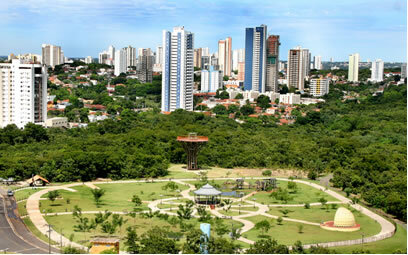Mato Grosso is a Brazilian state located in the Midwest region. Its territorial extension is 903,329,700 square kilometers, making it the largest state in the region and the third largest in Brazil.
According to the population count carried out in 2010 by the Brazilian Institute of Geography and Statistics (IBGE), Mato Grosso has 3,035,122 inhabitants, which represents 1.59% of the Brazilian population. It is the second most populous state in the Midwest region, only the state of Goiás has a higher population (6,003,788 inhabitants). However, the territory of Mato Grosso has large demographic gaps, a fact that directly interferes with state demographic density, which currently is 3.3 inhabitants per square kilometer, so the state is sparsely populated. The demographic growth rate is 1.9% per year.

Cuiabá, capital and most populous city in Mato Grosso
The majority of Mato Grosso residents live in urban areas (82%), the rural population comprises 18%. The state has 141 municipalities, most of which are inhabited by less than 20 thousand people. Cuiabá, capital of the state, is the most populous city – 551,098 inhabitants. Other municipalities with high population concentration are: Várzea Grande (252,596), Rondonópolis (195,476), Sinop (113.099), Cáceres (87,942), Tangará da Serra (83,431).
In recent years, Mato Grosso has received considerable migratory flows, as a result of the expansion of the agricultural frontier. The population of the state is formed by people of different ethnic composition. According to IBGE data, the distribution is as follows:
Browns – 55.2%.
Whites – 36.7%.
Blacks – 7%.
Indigenous people – 1.1%.
Therefore, the inhabitants who declare themselves as brown is the majority. The indigenous population of Mato Grosso is concentrated in the Xingu National Park, where indigenous tribes live there that preserve the Kuarup tradition, a ritual performed in honor of the dead.
The state has great cultural plurality, among the elements of Mato Grosso culture are: o Cururu, Siriri, Rasqueado Cuiabano, Boi, Dança de São Gonçalo, Dança dos Mascarados and Congo.
Mato Grosso occupies the 11th position in the national ranking of the Human Development Index (HDI), with an average of 0.796. The state infant mortality rate is 19.2 per thousand children born alive, this average is the highest in the Midwest. The murder rate per 100,000 inhabitants is 25.2, which is one of the highest averages in the country. Most of the inhabitants are literate – 89.8%, and 48.7% have eight or more years of schooling.
Do not stop now... There's more after the advertising ;)
By Wagner de Cerqueira and Francisco
Graduated in Geography
Brazil School Team
Mato Grosso - Midwest region
geography of Brazil - Brazil School
Would you like to reference this text in a school or academic work? Look:
FRANCISCO, Wagner de Cerqueira and. "Aspects of the population of Mato Grosso"; Brazil School. Available in: https://brasilescola.uol.com.br/brasil/aspectos-populacao-mato-grosso.htm. Accessed on June 28, 2021.
